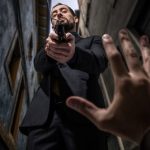 Creepy
Creepy  Creepy
Creepy  Technology
Technology 10 Scientific Breakthroughs of 2025 That’ll Change Everything
 Our World
Our World 10 Ways Icelandic Culture Makes Other Countries Look Boring
 Misconceptions
Misconceptions 10 Common Misconceptions About the Victorian Era
 Mysteries
Mysteries 10 Strange Unexplained Mysteries of 2025
 Miscellaneous
Miscellaneous 10 of History’s Most Bell-Ringing Finishing Moves
 History
History 10 Great Escapes That Ended Right Back in Captivity
 Weird Stuff
Weird Stuff 10 Fascinating Things You Might Not Know About Spiders
 Food
Food 10 Everyday Foods You Didn’t Know Were Invented by the U.S. Military
 History
History 10 Odd Things Colonial Americans Kept at Home
 Creepy
Creepy 10 More Representations of Death from Myth, Legend, and Folktale
 Technology
Technology 10 Scientific Breakthroughs of 2025 That’ll Change Everything
 Our World
Our World 10 Ways Icelandic Culture Makes Other Countries Look Boring
Who's Behind Listverse?

Jamie Frater
Head Editor
Jamie founded Listverse due to an insatiable desire to share fascinating, obscure, and bizarre facts. He has been a guest speaker on numerous national radio and television stations and is a five time published author.
More About Us Misconceptions
Misconceptions 10 Common Misconceptions About the Victorian Era
 Mysteries
Mysteries 10 Strange Unexplained Mysteries of 2025
 Miscellaneous
Miscellaneous 10 of History’s Most Bell-Ringing Finishing Moves
 History
History 10 Great Escapes That Ended Right Back in Captivity
 Weird Stuff
Weird Stuff 10 Fascinating Things You Might Not Know About Spiders
 Food
Food 10 Everyday Foods You Didn’t Know Were Invented by the U.S. Military
 History
History 10 Odd Things Colonial Americans Kept at Home
10 Shocking Crimes Where the Perpetrator Walked Free
The legal system operates on a fundamental principle: a person is presumed innocent until proven guilty beyond a reasonable doubt. For the general public, this can sometimes lead to jarring and controversial outcomes. In certain high-profile cases, the facts of a crime seem clear. Yet, the legal defenses and trial procedures result in a stunning acquittal.
These are the stories of ten shocking crimes where the perpetrator, for a variety of bizarre or legally complex reasons, was ultimately set free, leaving a lingering sense of disbelief and a profound impact on victims’ families and the public.
Related: Top 10 People Found Guilty At Trial Due To Surprise Evidence
10 Robert Durst: The Case of the Dismembered Neighbor
In 2001, Robert Durst, a scion of a New York real estate dynasty, was charged with the murder of his neighbor, Morris Black, in Galveston, Texas. The evidence seemed damning: Durst admitted to dismembering Black’s body and dumping the parts into Galveston Bay. Furthermore, Durst was a suspect in the 1982 disappearance of his first wife and the 2000 murder of his friend, Susan Berman, which gave him a clear motive for avoiding law enforcement.
The defense, led by famed attorney Dick DeGuerin, chose a shocking and audacious strategy. They argued that Durst had not murdered Black but had killed him in self-defense. The defense claimed that Durst, a frightened recluse, had struggled with an aggressive Black and that the gun had gone off accidentally. The dismemberment, they argued, was a panic-driven act by a man who feared no one would believe his self-defense story given his past.
Despite the fact that Durst had admitted to mutilating the body and discarding it, the jury acquitted him of murder. They found him guilty only of jumping bail and evidence tampering, for which he served a short sentence. The verdict stunned the nation. Durst later confessed to the other murders in the HBO documentary The Jinx, but the Texas jury’s decision remains a testament to the power of a compelling legal defense, even in the face of what appeared to be overwhelming evidence.[1]
9 Amanda Knox and Raffaele Sollecito: The Murder in Perugia
In 2007, American exchange student Amanda Knox and her Italian boyfriend, Raffaele Sollecito, were charged with the brutal murder of Knox’s roommate, Meredith Kercher, in Perugia, Italy. The case captivated international media with its salacious details. The prosecution painted Knox as a manipulative, promiscuous liar, and Sollecito as her accomplice. The initial conviction was based on a combination of what was later deemed unreliable DNA evidence and circumstantial accounts of the night.
The defense’s argument was one of police and prosecutorial incompetence. They systematically dismantled the prosecution’s case by questioning the validity of key forensic evidence. They highlighted the flawed handling of evidence at the crime scene, arguing that the DNA evidence used to link Knox and Sollecito to the crime was contaminated and that the witness testimonies were inconsistent.
After four years in prison, Knox and Sollecito were acquitted of the murder on appeal in 2011, and the verdict was finalized by Italy’s Supreme Court in 2015. The final acquittal was a stunning reversal that exposed deep flaws in the Italian justice system and underscored the danger of a conviction built on a weak foundation.[2]
8 George Zimmerman: The Trayvon Martin Shooting
On a rainy night in 2012, neighborhood watch volunteer George Zimmerman shot and killed 17-year-old Trayvon Martin in Sanford, Florida. Zimmerman, who had been following Martin because he deemed him “suspicious,” claimed he had shot the unarmed teenager in self-defense after a physical altercation. The case ignited a firestorm of national debate about race, gun laws, and vigilante justice.
The prosecution struggled to disprove Zimmerman’s self-defense claim under Florida’s “Stand Your Ground” law. The law gives an individual the right to use lethal force when they reasonably believe it is necessary to prevent death or great bodily harm. The defense argued that Martin had initiated the physical fight, and therefore Zimmerman was justified in using his firearm. The lack of a clear, third-party eyewitness to the precise moment of the fatal shot made it difficult for the prosecution to counter Zimmerman’s version of events.
The jury ultimately acquitted Zimmerman of both second-degree murder and manslaughter. The verdict sparked protests and outrage across the country, as many felt that a young, unarmed Black man had been unjustly killed and that the shooter had been given a free pass. The case continues to be a flashpoint in American society and has led to a re-examination of self-defense laws and the justice system’s handling of racial dynamics.[3]
7 Lyle and Erik Menendez: The First Murder Trial
In 1989, Lyle and Erik Menendez shot and killed their wealthy parents, Jose and Kitty Menendez, in their Beverly Hills home. The public and prosecutors initially saw the case as a clear example of greed, arguing that the brothers had committed the murders to inherit their parents’ $14 million fortune. The cold-blooded nature of the crime and the brothers’ lavish spending in the aftermath seemed to confirm this motive.
The defense’s argument was shocking and deeply unsettling. The brothers’ attorney, Leslie Abramson, claimed they had killed their parents in self-defense after years of extreme physical, emotional, and sexual abuse. The brothers’ testimonies were highly emotional and detailed, and they provided a compelling narrative of a family so dysfunctional and abusive that the only escape was violence. The jury became deeply divided on the issue of abuse versus greed.
The first trial ended in a hung jury, with two juries—one for each brother—unable to reach a verdict. One jury deadlocked 10–2 in favor of acquittal, while the other deadlocked 7–5. While they were not fully let free, the public’s perception of the brothers changed drastically, and the hung juries were a stunning outcome for a case that had initially seemed open-and-shut. A second trial, where cameras were not allowed, resulted in a conviction of both brothers on two counts of first-degree murder, but the first trial’s shocking result stands as a powerful example of a defense narrative that nearly overcame all evidence.[4]
6 Dan White: The “Twinkie Defense”
In 1978, former San Francisco city supervisor Dan White murdered Mayor George Moscone and Supervisor Harvey Milk, a groundbreaking gay rights activist. The murders were not disputed; White had walked into City Hall, shot both men, and confessed to the crime. The prosecution sought a first-degree murder conviction, confident that the cold-blooded nature of the assassinations would lead to a swift verdict.
White’s defense was an incredibly bizarre and controversial one. The defense team argued that White was suffering from a diminished capacity due to depression, which had been exacerbated by his consumption of sugar-laden junk food, specifically Twinkies. The infamous “Twinkie defense” was a claim that the junk food had impaired White’s judgment and ability to premeditate the murders. While the term “Twinkie defense” was a media creation, the core of the legal argument centered on the idea that White’s poor diet contributed to his mental state, making him less culpable for the crime.
The jury was shockingly receptive to the diminished capacity defense. They acquitted White of first-degree murder and convicted him only of voluntary manslaughter. White served just over five years in prison, an outrageously light sentence that was met with fury and riots in the LGBTQ+ community. The verdict was a stunning legal outcome that highlighted the pitfalls of using psychiatric defenses to mitigate culpability, and it led to the state of California abolishing the diminished capacity defense.[5]
5 Casey Anthony: The Murder of Caylee Anthony
In 2008, a two-year-old girl named Caylee Anthony disappeared in Orlando, Florida. Her mother, Casey Anthony, did not report her missing for 31 days and gave a series of bizarre and conflicting accounts to police, including the claim that a nanny named “Zanny the Nanny” had kidnapped Caylee. When the child’s remains were found in a wooded area near the family home, Casey Anthony was charged with her murder.
The prosecution’s case was entirely circumstantial. They argued that Anthony had sedated her daughter and suffocated her, but they could not definitively prove the cause of death. The defense argued that Caylee had drowned accidentally in the family swimming pool and that her grandfather had covered up the death. The defense painted Anthony as a troubled young woman whose lies were a result of a dysfunctional family, not a guilty conscience.
The jury acquitted Anthony of first-degree murder, aggravated child abuse, and aggravated manslaughter. She was only convicted of four counts of providing false information to law enforcement. The verdict was a national shockwave, with the public and media largely convinced of her guilt. Legal experts pointed to the prosecution’s failure to provide a definitive cause of death and a clear motive, allowing the jury to cling to the principle of reasonable doubt.[6]
4 O.J. Simpson: The “Trial of the Century”
In 1994, former football star and actor O.J. Simpson was charged with the murders of his ex-wife Nicole Brown Simpson and her friend Ron Goldman. The prosecution had what seemed to be a mountain of evidence, including DNA connecting Simpson to the crime scene, blood in his vehicle, and the infamous “bloody glove” found on his property.
The defense, a team of high-profile lawyers dubbed the “Dream Team,” chose a brilliant, though controversial, strategy. They put the police on trial, arguing that the evidence was mishandled and that detectives were racist and had planted evidence. The defense’s most powerful moment came when they had Simpson try on a glove found at the crime scene. The glove did not fit, leading to the famous line from defense attorney Johnny Cochran, “If it doesn’t fit, you must acquit.”
The jury, after less than four hours of deliberation, acquitted Simpson of both murder charges. The verdict divided the nation, with many believing the “Dream Team” had successfully used reasonable doubt and the history of racial tension in Los Angeles to undermine what was otherwise a strong case. The trial exposed the flaws of a legal system that, at times, struggles to balance justice with the theatrics of high-stakes, celebrity-driven litigation.[7]
3 Lizzie Borden: The Ax Murders
In 1892, Lizzie Borden was accused of brutally murdering her father and stepmother with an ax in Fall River, Massachusetts. The crime captivated the nation, and the evidence against Borden appeared compelling. She was the only person in the house at the time of the murders besides her father and stepmother, she had attempted to burn a dress that was possibly stained with blood, and she gave inconsistent and contradictory statements to police.
Despite the evidence, Borden’s defense team masterfully painted a picture of a gentle, middle-class woman incapable of such a heinous crime. They capitalized on the societal perception of a well-bred woman, arguing that the idea of a respectable lady committing such a savage double murder was simply unthinkable. Furthermore, a crucial piece of evidence—the head of a hatchet found in the basement—was not admitted into court, weakening the prosecution’s case.
The jury, after a little more than an hour of deliberation, acquitted Borden of all charges. The verdict stunned a public that was largely convinced of her guilt. She was legally a free woman, but she was ostracized by the community and lived as a recluse for the rest of her life. The case remains one of America’s most famous unsolved mysteries, with the legal acquittal standing in stark contrast to the public’s enduring belief in her guilt.[8]
2 The 1994 Killing of Jonathan Wamback
In 1994, 15-year-old Jonathan Wamback was brutally beaten by a group of teenagers in a park in Newmarket, Ontario. The assault left him with severe brain damage, and he was left in a permanent vegetative state. The attack was witnessed by multiple people, and the perpetrators were a group of known bullies. The case was widely publicized and sparked national outrage in Canada.
The defense for the two teenage boys charged with the assault was unusual and focused on a single point: while they were indeed involved in the fight, they were not the ones who delivered the final, fatal blow. The defense argued that because the prosecution could not definitively prove which of the boys was responsible for the kick to the head that caused the brain damage, neither could be found guilty of the crime.
The judge, in a stunning verdict, agreed with the defense’s argument and acquitted both teens of aggravated assault. The judge stated that while the boys were “morally and ethically wrong,” the prosecution had failed to establish “who did what to whom.” The decision was met with a storm of public fury and a national call for legal reform. While the boys were ultimately charged and convicted of a lesser crime, the acquittal on the main charges was a shocking legal outcome that led to a major review of Canada’s legal system regarding group accountability in crimes.[9]
1 Brian Thomas: The Sleepwalking Husband
In 2009, Brian Thomas, a devoted husband, was accused of strangling his wife, Christine, in their camper van in Wales. The couple was on a road trip with their two daughters. After killing his wife, Thomas woke up and called emergency services, telling them he believed he had killed his wife. He later told police that he had been having a nightmare that he was fighting with an intruder in the van and that he had only realized what he had done when he woke up to his wife’s body.
Thomas’s defense was a plea of automatism—the claim that a person’s actions were not voluntary and they were not conscious of what they were doing. The defense presented evidence from sleep experts that Thomas suffered from a rare sleep disorder and was essentially acting out his nightmare. He was not a conscious participant in the act and therefore could not be held responsible for the death.
The judge, who heard the case without a jury, agreed with the defense’s argument. He stated that Thomas’s actions were “not the actions of a waking man” and that he had “no awareness of what he was doing.” Thomas was acquitted of murder and manslaughter and was released from court as a free man. The case was a rare and bizarre legal precedent, as it was a successful modern defense of automatism, where the perpetrator was absolved of guilt for a violent crime due to an unconscious act.[10]








